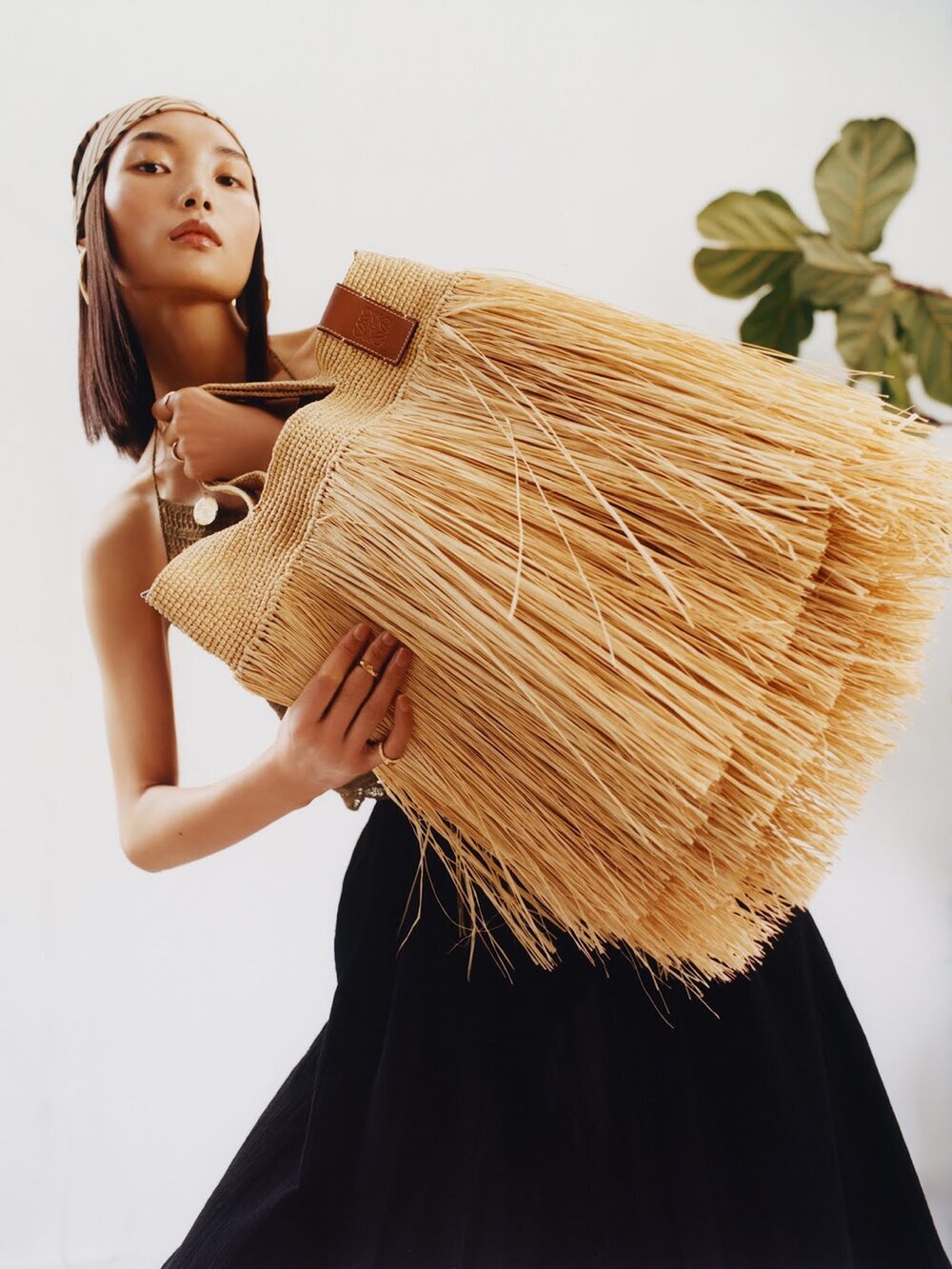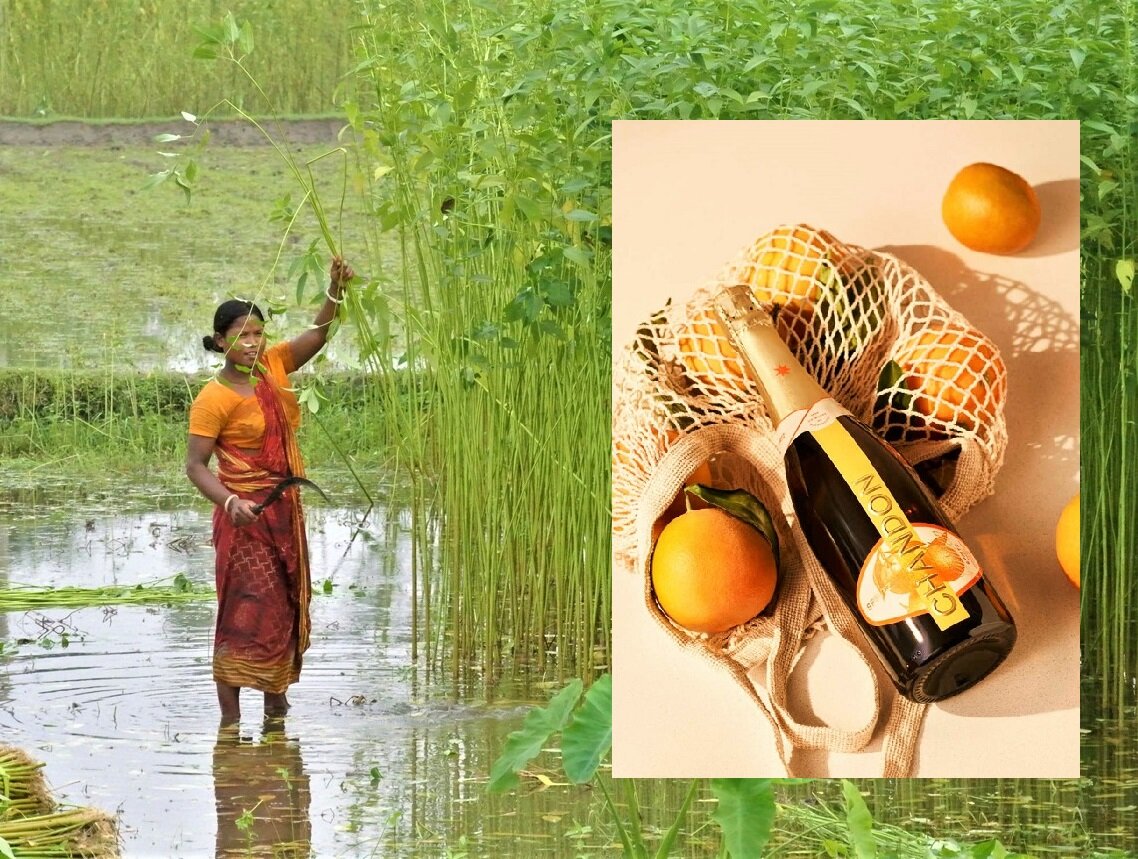Raffia: AOC Launches Earth-Friendly Fibers Sustainable Inquiry in Fashion and Design
/Ling Chen in 'Spirited Away' Lensed by Juliette Cassidy for Porter Edit May 14, 2021 AOC Fashion
In Praise of Earth-Friendly Fibers
AOC’s heart did a little dance yesterday, seeing this Loewe + Paula’s Ibiza totem-worthy, raffia bag in the NET-A-PORTER ‘Spirited Away’ fashion story. I’ve had raffia on my brain — and hemp, jute, burlap, rattan — not even understanding that some words are weaves and others the plant.
Looking at Loewe’s superb Paula’s Ibiza bag under more scrutiny, I felt let down that bits of leather were part of the prize, when cactus leather was an option. AOC longs for the day when DESSERTO® cactus-based vegan leather or any of the other new leather substitutes gaining traction in the luxury market deliver raffia bag designs that are 100% sustainable. To be fair, maybe Stella McCartney rummaging through the deadstock LVMH archives resulted in the Loewe leather. If you recall, Stella made that exact effort for her only LVMH boss — Bernard Arnault — when the subject is sustainability.
The deeper AOC delves into sustainability and sustainable fibers, the more intensely I feel the contradictions in my own GlamTribal jewelry collection. Determined to give up leather myself — or in the worst case, only buy deadstock leather — I ordered up some raffia in mid-April.
It’s correct to say that I haven’t looked back since I undertook my own self-education on natural fibers — where they are grown, how they are dyed, what are their strengths and weaknesses. I’ve fallen for a few fakes along the way — astounded to discover that a natural-fiber appearing bag from a top luxury brand is pure petroleum and chemicals.
Totally determined to be part of the sustainability solution for the fashion industry, AOC is launching a new, sustainability-driven collection of articles — Earth Friendly Fibers — inspired by our inventive Google searches.
Some new articles are obvious — like why are jute rugs in such high demand. Other Earth Friendly Fibers articles are more obscure.
In my recent jute search, the packaging in LVMH’s Chandon Garden Spritz came up in AOC’s Google page 1 results. This hip jute bag is a toss-up for including an entire appertif brand in AOC’s new Earth-Friendly Fibers collection. I hear you saying: “We thought you have high standards, Anne.”
Chandon Garden Spritz's Artisanal, Sustainable Spirit Splash Comes With Bit of Jute AOC Living
The more AOC read about the Chandon Garden Spritz, the more perfect it became for Anne of Carversville. Yes, jute is a small part of the story. But the rest is pretty darn AOC.
1) Created by a barely 30-year-old woman, Ana Paula Bartoluci — the only female winemaker in 60 years at Chandon Argentina. √ 2) Launched by Chandon’s female president Sibylle Scherer √. 3) “I’m really very proud of this recipe because it’s unique: it’s made only with natural ingredients,” the young, visionary winemaker Bartoluci explains. “The oranges are grown on a pesticide-free family farm, with dried and fresh rinds going into the blend. The juice is donated to local schoolchildren, while the waste gets used for compost.” √√√√ SOLD to AOC!
So yes, jute packaging is a bit of a reach, when our big focus is an entire handbag or luxury car seat. BUT, all the other sustainability and AOC activism bonafides are solid, so Chandon Garden Spritz is in the mix. Let’s cross our fingers that Chandon is paying a fair-trade price for the jute bag, one preferably made in a women’s collective.
Jute, Raffia — it’s all the same Right? NO, it’s NOT all the same.
About Raffia
As a natural fiber, raffia shares properties similar to jute, bamboo and hemp. The raffia fiber is soft, pliable, strong, durable, easy to dye and biodegradable , writes Textile Value Chain.
Raffia an excellent material for weaving baskets, hats, mats and rugs. It’s widely used for agricultural purposes to tie vegetables, plants in vineyards, flowers and floral arrangements. My many sources of African beads, typically arrive on raffia.
When it’s produced in color raffia is normally dyed with natural pigments. Based only on AOC’s preliminary investigation of Earth-Friendly Fibers, raffia is free from fertilizers and pesticides. The plant is only harvested when fully mature.
The very scale of raffia is awesome. Raffia palms are a genus of abojut 20 species of palms native to tropical regions of Africa. In particular, raffia is found and harvested in Madagascar. Raffia palms grow over 50 ft. tall, with leaves that are the longest in the longest in the plant kingdom. The actual fiber is produced from the membrane on the underside of each individual frond leaf, writes Wiki.
The plants are monocarpic, meaning that they flower once and die after seeds are mature. However, the roots remain alive and send forth new stems — making the raffia palms more like a perennial plant in our everyday experience.
Because the raffia palm dies down and must regenerate itself, and because the majority of raffia trees are confined to the continent of Africa, this simple and humble fiber is not harvested in abundance.
As noted Monday by WSJ Magazine senior market editor Libby Page, natural fibers like raffia have gone upscale. Today’s eco-friendly raffia is a highly-prized, sustainable material that has graduated from the boho hippie crowd and is now living in the high-rent district from New York to London, Paris and presumably Shanghai.
Fake Raffia
Even Wiki cites the existence of fake raffia produced from polypropylene. The first company in the world to design and build plants for the production of polypropylene raffia was the Covema of Milan founded by the brothers Dino Terragni and Marco Terragni in 1953.
The fake raffia bag I referenced at the beginning of this article is from a prominent Italian brand, and only each customer can determine what the reality of fake raffia means in the grand scheme of modern living. Some of us want absolutely nothing to do with fake raffia, and others are fine with the product, as long as it looks good and luxurious.
It’s important to note that researchers enthralled with natural fibers like raffia, bamboo, jute, hemp and more are exploring sustainable treatments to make the performance of these fibers even more long-lasting.
Speaking for AOC, I am both learning how to make my own crazy glue but also understanding that sustainable silicone is a reality. There are resins that I can work with that are not harmful to the earth. Now that AOC — and Anne — understand that we can make our own crazy glue that is kind to the environment, we are not running away from scientific advancements in new fiber technology either.
As the best Internet researcher I know, AOC shares this 2018 scientific article titled “Characterization of raffia palm fiber for use in polymer composites”, published in the Journal of Wood Science. As we speak, scientists are marrying raffia and polymers in attempts to not lose any sustainability benefits while developing important new uses for raffia as an enhanced building material.
While some Earth-Friendly Fibers posts will focus on helping us understand a single fiber and its properties, many will focus on brands generally and new uses for these high-quality, sustainable materials. We will also focus on sourcing these life-generating materials, and the growers and workers who bring them to market. ~ Anne
Related: 6 Reasons Why Interior Designers Vouch For Jute Rugs | AOC Agrees



